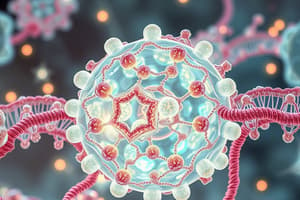Podcast
Questions and Answers
The Na+ concentration is higher inside the cell compared to outside.
The Na+ concentration is higher inside the cell compared to outside.
False (B)
The K+ concentration is higher inside the cell compared to outside.
The K+ concentration is higher inside the cell compared to outside.
True (A)
The total positive ions inside and outside the cell are 160 mmol/L.
The total positive ions inside and outside the cell are 160 mmol/L.
False (B)
The RMP of a typical neuron is +70 mV.
The RMP of a typical neuron is +70 mV.
The resting potential is a unique property only found in neurons.
The resting potential is a unique property only found in neurons.
The extracellular potential is defined as -70 V in the custom definition of RMP.
The extracellular potential is defined as -70 V in the custom definition of RMP.
Depolarization is caused by the net flow of positive charges into the cell.
Depolarization is caused by the net flow of positive charges into the cell.
Repolarization is when the cell experiences an increase in voltage due to the influx of potassium (K+) ions.
Repolarization is when the cell experiences an increase in voltage due to the influx of potassium (K+) ions.
Hyperpolarization occurs due to the net flow of positive charges into the cell.
Hyperpolarization occurs due to the net flow of positive charges into the cell.
At the threshold potential, the cell membrane opens up allowing Na+ transport.
At the threshold potential, the cell membrane opens up allowing Na+ transport.
The resting potential of the membrane is +70 mV.
The resting potential of the membrane is +70 mV.
Action potential propagation involves the unusual activity of electrical signal degradation.
Action potential propagation involves the unusual activity of electrical signal degradation.
Graded potentials are major changes in membrane potential due to the binding of neurotransmitters.
Graded potentials are major changes in membrane potential due to the binding of neurotransmitters.
Action potentials have relatively large depolarizations by 50–60 mV above the resting value of −70 mV.
Action potentials have relatively large depolarizations by 50–60 mV above the resting value of −70 mV.
Successive graded potentials can add to one another and propagate long distances along the membrane.
Successive graded potentials can add to one another and propagate long distances along the membrane.
Action potentials are qualitatively similar to graded potentials in every aspect.
Action potentials are qualitatively similar to graded potentials in every aspect.
The resting membrane potential is approximately -90 mV.
The resting membrane potential is approximately -90 mV.
Cell membranes allow ion leakage through the membrane due to the binding of neurotransmitters.
Cell membranes allow ion leakage through the membrane due to the binding of neurotransmitters.
Flashcards are hidden until you start studying
Study Notes
Ion Distribution Across the Cell Membrane
- There is a higher concentration of Na+ (145 mmol/L) outside the cell than inside (14 mmol/L)
- There is a higher concentration of K+ (140 mmol/L) inside the cell than outside (5 mmol/L)
- The total concentration of positive ions inside and outside the cell is 165 mmol/L
Resting Membrane Potential (RMP)
- The RMP is the voltage across a cell membrane during the resting stage
- In neuromuscular tissues, the RMP of a typical neuron is about −70 mV, with the interior of the cell negative in charge to the outside
- The basis for the RMP is the unequal distribution of ions, particularly K+ and Na+, on either side of the plasma membrane
Action Potential
- The propagation of an electrical signal would constitute unusual activity
- Depolarization is due to the net flow of positive charges into the cell or negative charges to regions outside the cell
- Repolarization is a stage of an action potential in which the cell experiences a decrease in voltage due to the efflux of potassium (K+) ions along its electrochemical gradient
- Hyperpolarization is due to the net flow of negative charges into the cell or positive charges to outside the cell, resulting in a polarized state
Types of Cell Membrane Excitations
- There are two types of axon excitations: graded potentials and action potentials
- Graded potentials are minor perturbations in the membrane potential due to the binding of neurotransmitters, the stimulation of sensory reception, or spontaneous ion leakage through the cell membrane
- Successive graded potentials can add to one another, but they only propagate short distances along the membrane before decaying
- Action potentials are qualitatively different from graded potentials, with relatively large depolarizations above the resting value of −70 mV to a threshold of about −55 mV
Studying That Suits You
Use AI to generate personalized quizzes and flashcards to suit your learning preferences.




